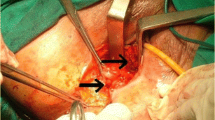Abstract
The results of 81 endorectal flap advancements for simple rectovaginal fistulas are reported. Simple fistulas are defined as <2.5 cm in diameter, low or mid vaginal septum in location, and infectious or traumatic in origin. Essentially, the technique is advancement of a flap of mucosa, submucosa, and circular muscle over midline approximation of internal sphincter muscle. The mean patient age was 34 years old (range, 18 to 76 years). The causes were obstetrical injury (74 percent), perineal infection (10 percent), operative trauma (7 percent), and unknown (8 percent). Overall, the repair was successful in 83 percent of patients. Success correlated with the number of previous repairs,i.e., none: 88 percent success; one: 85 percent success; two: 55 percent success. There were 25 concomitant overlapping sphincteroplasty procedures. Only minor complications ensued, with no mortality. This repair is recommended for patients with no or one previous repair because of its lack of mortality, minimal morbidity, ease of concomitant sphincteroplasty, and avoidance of a colostomy. For patients with two or more earlier repairs, a muscle interposition should be considered.
Similar content being viewed by others
References
Rothenberger DA, Christenson CE, Balcos EG, et al. Endorectal advancement flap for treatment of simple rectovaginal fistula. Dis Colon Rectum 1982;25:297–300.
Hibbard LT. Surgical management of rectovaginal fistulas and complete perineal tears. Am J Obstet Gynecol 1978;130:149–41.
Shieh CJ, Gennaro AR. Rectovaginal fistula: a review of 11 years experience. Int Surg 1984;69:69–72.
Russell TR, Gallagher DM. Low rectovaginal fistulas: approach and treatment. Am J Surg 1977;134:13–8.
Corman ML. Colon and rectal surgery. Philadelphia: JB Lippincott, 1984.
Greenwald JC, Hoexter B. Repair of rectovaginal fistulas. Surg Gynecol Obstet 1978;146:443–5.
Boronow RC. Repair of the radiation-induced vaginal fistula utilizing the Martius technique. World J Surg 1986;10:237–48.
Zacharain RF. Grafting as a principle in the surgical management of vesicovaginal and rectovaginal fistulae. Aust NZ J Obstet Gynecol 1980;20:10–7.
Hilsabeck JR. Transanal advancement of the anterior rectal wall for vaginal fistulas involving the lower rectum. Dis Colon Rectum 1980;23:236–41.
Mengert WF, Fish SA. Anterior rectal wall advancement: technique for repair of complete perineal laceration and rectovaginal fistula. Obstet Gynecol 1955;5:262–7.
Hoexter B, Labow SB, Moseson MD. Transanal rectovaginal fistula repair. Dis Colon Rectum 1985;28:572–5.
Author information
Authors and Affiliations
Additional information
Read at the meeting of the American Society of Colon and Rectal Surgeons, Washington, D.C., April 5 to 10, 1987.
About this article
Cite this article
Lowry, A.C., Thorson, A.G., Rothenberger, D.A. et al. Repair of simple rectovaginal fistulas. Dis Colon Rectum 31, 676–678 (1988). https://doi.org/10.1007/BF02552581
Issue Date:
DOI: https://doi.org/10.1007/BF02552581




